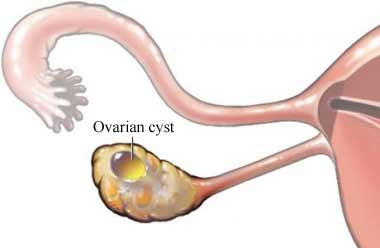OVARIAN CYSTS

What are ovarian cysts? A cyst is a little balloon filled with air or fluid on one of the ovaries, which then exerts pressure on the right or left side of the lower abdomen. These cysts can be painful. Besides the pain in the lower abdomen, some other symptoms are: erratic, painful periods, often with much uterine bleeding as a result of elevated estrogen levels, painful intercourse, and excessive hair growth.
Many women will develop ovarian cysts at some point during their lives. They are one of the most common reasons women seek gynecologic consultation. Ovarian Cyst Treatment will depend on the type of cyst, your age, and your general health.
TYPES OF OVARIAN CYSTS

Functional Cysts
The majority of ovarian cysts form naturally as a result of menstrual cycles during a woman’s reproductive years. Leading up to ovulation, your ovaries grow small follicles. The follicles release hormones and expel the egg when you ovulate. Sometimes, a normal follicle will continue to grow and retain fluid after your menstrual cycle; this is known as a functional cyst. They are almost always harmless, typically shrinking and disappearing on their own within four to eight weeks.
Benign Neoplastic Cysts
These types of cysts are rare and present in a variety of forms. These cysts are characterized by abnormal tissue growth. The most common type of benign neoplastic cysts is the cystic teratoma, also known as a dermoid cyst. Developing from a germ cell, these cysts can contain multiple types of tissue, including sebaceous glands, skin cells, or hair follicles. Sometimes these cysts cause no symptoms, but occasionally they can produce other medical complications and pelvic pain. Usually, these types of cysts do not resolve on their own.
Endometriotic Cysts
Developing as a result of endometriosis, these cysts develop when endometrial-like tissue grows outside of the uterus and becomes attached to the ovaries. During a menstrual cycle, hormones trigger uterine tissue to be shed after ovulation and exit the body. Endometrial tissue on the ovaries cannot be shed, causing the tissue to accumulate, and form dark, reddish-brown cysts. For this reason, endometriotic cysts are commonly referred to as “chocolate cysts.” These cysts usually do not resolve spontaneously, and if they rupture, can cause pelvic pain, adhesions, and infertility.
Malignant Cysts
Developing as a result of endometriosis, these cysts develop when endometrial-like tissue grows outside of the uterus and becomes attached to the ovaries. During a menstrual cycle, hormones trigger uterine tissue to be shed after ovulation and exit the body. Endometrial tissue on the ovaries cannot be shed, causing the tissue to accumulate, and form dark, reddish-brown cysts. For this reason, endometriotic cysts are commonly referred to as “chocolate cysts.” These cysts usually do not resolve spontaneously, and if they rupture, can cause pelvic pain, adhesions, and infertility.
COMPLICATIONS
Rupture
It is relatively common for a woman of reproductive age to have an ovarian cyst rupture. This can be painless and go unnoticed, but is also be associated with the sudden onset of lower abdomen pain, typically on one side of the body. The pain usually begins during physical activity, which caused the cyst to rupture. Other conditions with similar symptoms include ovulation pain, ectopic pregnancy and ovarian torsion, which must be ruled out before a treatment plan can be determined. Often ruptured cysts do not need treatment beyond pain medication and observation, but if a woman’s blood pressure becomes unstable or bleeding continues, surgical intervention may be necessary.
Ovarian Torsion
Sometimes ovarian cysts become enlarged to such a degree that they can cause the ovary to twist out of its natural position, partially or fully inhibiting blood supply to the ovary. This is called ovarian torsion. Symptoms are acute and sudden and include lower abdominal pain, often unilateral, as well as nausea or vomiting. It is among the most common gynecologic emergencies, requiring surgical ovarian cyst treatment to correct.
